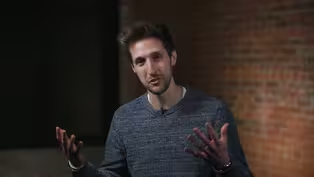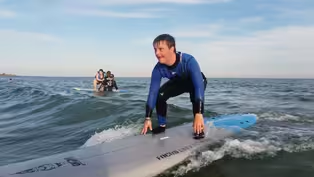
Flash of Light
Clip: Season 5 Episode 32 | 8m 48sVideo has Closed Captions
Photographer captures lighthouses at night under star-studded sky.
Photographer David Zapatka works under a star-studded sky taking photos of lighthouses long after the sun has gone down. He goes to great lengths to capture the images, including wading into the water at night. Zapatka says the effects of climate change have created a sense of urgency to capture as many working lighthouses as possible.
Problems playing video? | Closed Captioning Feedback
Problems playing video? | Closed Captioning Feedback
Rhode Island PBS Weekly is a local public television program presented by Rhode Island PBS

Flash of Light
Clip: Season 5 Episode 32 | 8m 48sVideo has Closed Captions
Photographer David Zapatka works under a star-studded sky taking photos of lighthouses long after the sun has gone down. He goes to great lengths to capture the images, including wading into the water at night. Zapatka says the effects of climate change have created a sense of urgency to capture as many working lighthouses as possible.
Problems playing video? | Closed Captioning Feedback
How to Watch Rhode Island PBS Weekly
Rhode Island PBS Weekly is available to stream on pbs.org and the free PBS App, available on iPhone, Apple TV, Android TV, Android smartphones, Amazon Fire TV, Amazon Fire Tablet, Roku, Samsung Smart TV, and Vizio.
Providing Support for PBS.org
Learn Moreabout PBS online sponsorship- If you think of a lighthouse, it does its work at night, primarily.
To not have that recorded in history is a shame.
- [Michelle] David Zapatka has been recording history for more than three decades.
He's an award-winning videographer, but his biggest project yet has him picking up his still camera.
- And I didn't realize that this was a project till I was 15 or 20 lighthouses in, and that's when I was doing more research on more lighthouses, realizing, wow, there's no pictures of this lighthouse - [Michelle] Zapatka is the president of the Friends of Plum Beach Lighthouse, in North Kingstown.
He's long been mesmerized by lighthouses, not just by how they look, but by their history.
- But there are so many others with these great stories behind them.
- [Michelle] Since 2013, he's photographed more than 175 lighthouses in the United States, including many on the eastern seaboard.
- [David] Oh, we got stars.
That's a good thing.
- [Michelle] His goal, to capture every working lighthouse around the country at night.
The idea came to him while he was out boating with his wife on Narraganset Bay.
- So we're anchored off Dutch Island, and I said to my wife, "Wouldn't it be cool to see if I can get shots of the Dutch Island lighthouse at night, under the stars?"
- [Michelle] Zapatka says it's a photography project that hasn't been done before.
- What the digital camera has allowed us to do was to open up to photographers this whole new field of shooting when the sun goes down.
These are the slick ones.
They're not too bad, 'cause the tide is on the way in, so they're a little bit dry.
- [Michelle] What you can't see in Zapata's photos are the great lengths he goes to in order to capture these images.
It's not a stretch to say you're putting your life at risk on some of these shoots.
- Early on, I realized that it's dangerous at night.
Almost there.
A little bit further out, then we get the reflection.
That's always the bonus.
- [Michelle] Zapatka often weighs knee-deep into water to take a photo.
On the night we went with him, it was this one, the Ned's Point Lighthouse in Massachusetts.
Other lighthouses are only accessible by boat.
To get an image like this, Zapatka put his 20-foot tripod in the water.
- So I can launch it off a boat, stick it down in the water, and get a shot of the lighthouse from the water that you couldn't normally get, 'cause your camera has to be completely steady for 20 seconds during new moon phase.
- [Michelle] Arriving at night to these lighthouses is not for the faint of heart.
Zapatka and his friend, Sean, found that out on a trip to Thacher Island to capture twin lighthouses.
- We're, like, right by the lighthouses, they're, like, right there.
It's like, there they are, let's keep going, let's shoot it.
So we tie the boat off at a mooring, and now we're facing to the wind, and now waves are coming over the bow of my 15-foot Boston Whaler, and it's, all hell's breaking loose.
The water's coming over, it's filling the back of the boat.
We're getting hit by wind, I'm at the bow of the boat, like, getting slammed, and I'm like, "You know what, Sean?
We gotta go."
And he was like, "Dave, you know, I'm with you, man."
- [Michelle] Never one to give up, he came back another night and captured the twins in all their glory.
Behind every photo are a host of safety measures, from a helmet with a headlamp to a personal radio beacon in the event of an emergency.
- [David] Nope, that's slick.
(laughs) Just when you think you're done.
- [Michelle] Even though he puts himself in some precarious situations, Zapatka says he is not a reckless risk-taker.
- But the thrill is I'm creating this history right in front of my eyes that no one's ever done before, and it's all going to be available through the United States Lighthouse Society.
- [Michelle] Whether it's the Borden Flats lighthouse in Massachusetts or Sankaty Head Lighthouse in Nantucket, photographing a lighthouse at night requires more than a skilled photographer and a good camera.
Zapatka times his photo shoots around the lunar calendar.
- So now here's what you need, new moon, or close to it, low tide, slack tide, which means that the tide has stopped, and no clouds, so- - Anything else?
- So why do you think it's taken me eight years to do only 175 lighthouses, roughly?
Because some of those conditions are so specific that you have to be patient to get that shot.
- [Michelle] And when it comes to patience, Zapatka has plenty of it.
- When I first started, I was self-teaching myself night photography, and I knew there was a thing called light painting.
We just use a flashlight.
So if you show up at Beavertail Lighthouse and it's dark, and it's night, you can light the lighthouse just with using a flashlight by waving it back and forth.
And I did that originally at Beavertail.
- [Michelle] He had already shot about a dozen lighthouses when he realized he could also use his battery-powered television lights.
- I use those dimmed down to almost nothing.
You could barely read by these lights, but over the sensitivity and the long exposure that I've created within the camera sensor, that light goes a long way.
- [Michelle] Your eyes are not deceiving you.
Still, don't expect this starry sky to look quite like this in person.
- The camera sees more than our eyes can see, so when you're standing here looking at Beavertail Lighthouse in the middle of the night, the Milky Way is there, and you can barely see it with your eyes, but the camera can see it better than you can, because it's seeing in this long exposure.
- [Michelle] Zapatka's photography collection was published in his first book, in 2017, "Stars and Lights: Darkest of Dark Nights."
Last year, he released the sequel, "Portraits from the Dark."
The project has been adopted by the United States Lighthouse Society and will live in their archives.
But you're hoping to take this RV to Michigan, to Florida, Ohio, all over the country.
- Yeah, farther and farther away.
- [Michelle] Zapatka has driven up and down the East Coast in this RV, photographing lighthouses, but he says the effects of climate change with rising tides present a real and present danger.
The work you're doing is really a race against time.
- Totally, and on many different levels.
The levels, talk about levels, the levels of the Great Lakes, last year, were higher than they've ever been.
They're down again this year, but if it gets higher again, there are several lighthouse that are threatened, because the foundations will just start crumbling, and potentially, those lighthouses could just fall into the lake.
- [Michelle] It's with that sense of urgency, that Zapatka approaches his work.
- To me, it has called out and said this needs to be done, and so I guess I'm the person to do it.
- Finally, urban explorers,
Video has Closed Captions
Clip: S5 Ep32 | 5m 38s | Filmmaker explores Rhode Island’s abandoned buildings. (5m 38s)
Video has Closed Captions
Clip: S5 Ep32 | 9m 31s | Surfers performing miracles with neurodivergent and non-ambulatory teens. (9m 31s)
Providing Support for PBS.org
Learn Moreabout PBS online sponsorshipSupport for PBS provided by:
Rhode Island PBS Weekly is a local public television program presented by Rhode Island PBS













